Supervised by: Liam Charles Obuobie MEng Hons, EngTech MIMechE. Liam is currently a final year Masters student of Mechanical Engineering at Newcastle University. He has secured a position as a Graduate Mechanical Building Services Engineer at Arup for post-graduate employment. His dissertation has garnered internation interest in further work.
Introduction
E-Scooters, as of today, are aimed at a younger target market; the Neuron app that works with the E-Scooters is easily accessible and straightforward for the technologically savvy. However, the total number of users may be limited due to many factors: the Neuron app being too confusing to the untrained eye or an out-of-date phone. In the UK, there is no set age when a person must legally stop driving; recent studies state that only 1 in 5 75-year-olds does not have a smartphone [1]. If an elderly person is legally allowed to drive and knows the rules of the road, they should be allowed to use an E-Scooter. The impracticality of carrying also imposes problems on the consumers; there is no suitable way to transport the scooter other than riding it. For this reason, a modification should be made to the E-Scooter’s design or functionality to broaden the target market and make it accessible to a wider variety of people.
User Requirements
In order to satisfy the users, it is necessary to have a thorough understanding of what the users’ needs are. While some are already satisfied with the current Neuron scooter and its sharing app, many requirements must be covered.
Users need to be assured of safety, meaning they need ready access to safety equipment like helmets and easy connections to emergency services. They also need the basics of the scooter to function fully; the scooters need to be regulated in some way. For example, the scooter lights should give users visibility while also allowing users to see ahead without blinding others. The handle grips must be made of good material to ensure the user’s comfort. Besides ensuring user safety, the scooter must regulate the users for dangerous behavior and use different functions to encourage them against it.
The structure of the scooter must be designed with a variety of users in mind. A suitable scooter needs: adjustable handlebars and a deck with the capacity for a range of weights, created with a light and sturdy material. The scooter must survive harsher weather conditions without injuring the user or harming the scooter.
The scooters should supply various users with a convenient structure and should be able to accommodate needs for unexpected situations. Users need baggage space for practicality and everyday use while also needing a light structure for safety and easy use.
Finally, the users need clear guidelines on using the scooters supplied by the platform and must have an infrastructure that allows professional involvement when necessary.
HTA Model
In order to identify improvements that can be made to the E-Scooter, a HTA model can be designed. This would be for reading the E-Scooter and essentially breaks down every step that needs to be taken in order to ride a Neuron electric scooter. By seeing this, it becomes easier to critique the product and find quicker and more efficient ways of carrying out tasks.

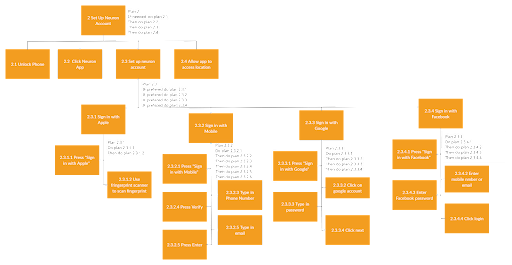



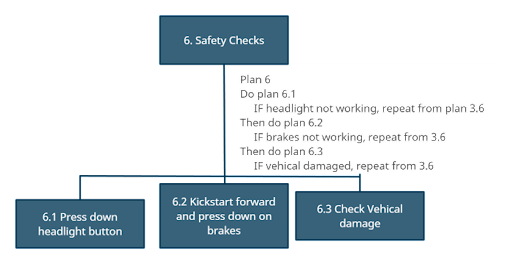
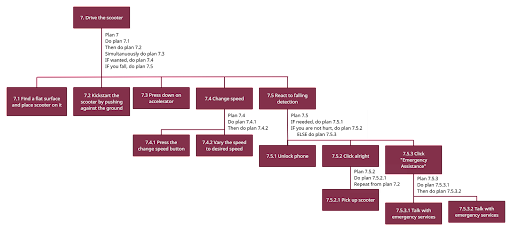
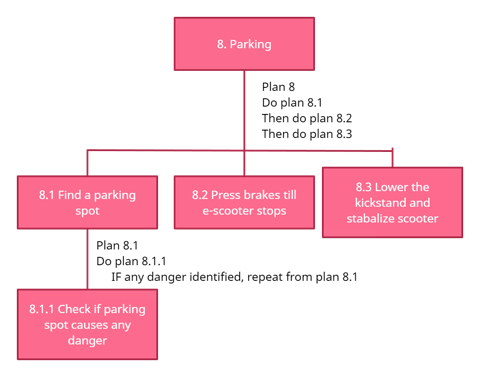
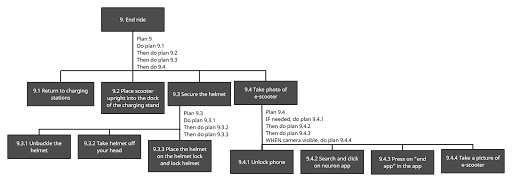
HTA Optimisations
Availability of E-Scooter is probability based. The app used to find an E-Scooter solely provides information regarding the location of parking/charging stations of E-Scooters. Therefore, when users arrive at any zone, it is based on chance whether they can find an E-Scooter or not. Furthermore, the user may find damaged E-Scooters or ones that do not have enough range for their journeys.
A way to reduce the time a user spends searching for E-Scooters is by adding the location of nearby E-Scooters rather than their charging stations. This way, the user can walk toward the nearest E-Scooter and use one immediately.
Each E-Scooter will also transmit data about itself, optimizing this even further. For example, how much range the E-Scooter has left, the hours used, and whether the E-Scooter is potentially damaged. The last piece of data, predicting the damage, can be done using information from previous rides on the scooter. The CE (Control Electronics) inside the scooter can count how many times the scooter has fallen since the last service/maintenance and use this data to predict whether the scooter is damaged. This information can also alert service authorities if a scooter needs attention due to its recent journeys.
Safety Check auto-procedures
Manual safety checks must be done by the user before each ride and tell the user whether the scooter is working correctly or not. Users who frequently use the E-Scooter will find this a tedious task and choose to avoid the necessary checks. Similarly, users in a hurry will not feel the need for these checks. We can reduce the manual labor for the user by implementing a procedure that takes care of all the safety checks before each ride and gives the user the results.
The procedure will handle two safety checks: A headlight check and a brake check.
Headlight check: This procedure will only be carried out when the journey is started less than an hour before sunset, and the procedure will be stopped once an hour has passed after sunrise. A light sensor outside the diffuser of the headlight will measure the lumens coming out of the E-Scooter. The data will be compared to the standard lumens expected from the headlight and displayed on the HUD (Heads Up Display). The metric will be a bar, like a battery, showing the headlight’s power.
Brake check: The CE will measure the pressure exerted by the hydraulic/electric braking system on the brake pads. The process will be repeated three times. The average of all pressure data will be calculated and compared to the standard pressure the system should exert. The results will be on the user’s HUD, shown as a percentage of the standard, letting the user know of the brake performance.
The Practicality of the Scooter in Case of Unplanned Incidents
While the scooter works fine in normal conditions, certain uncalled-for incidents might bring trouble to users in terms of how to continue to use the scooter. There are many cases where this could happen: if the scooter shuts down when entering a no-riding zone, in case a fall happens, when the user is looking for a safe surface to start riding the scooter, or when there are problems with the road ahead. The user might need to carry the scooter for a while in these situations. This might be troublesome, as the scooters don’t require physical training to use, and if people of lesser strength are not capable of using them, there would be issues with attainability. The solution is a carry strap. While this does not make the scooter any lighter, it helps with positioning the scooter while carrying it and therefore creates a more equal distribution of weight to carry.
The strap will be available beside the helmet and, when needed, will be attached to the carry hooks at the upper neck and the backside of the deck of the scooter. The user will then put the carry strap across their shoulder and carry it as needed. Though not perfect, this will improve the comfort of the process greatly and increase the quality of the user’s ride.
Further Improvements
The human systems integrated into the E-Scooter are also critical because they can drastically improve the efficiency of the product and the overall experience when using the product. Safety is a significant factor, especially when on the road, because if the user of the E-Scooter is not safe, this can also jeopardize the safety of drivers around them. The users are prohibited from looking at their phones during rides. However, the users need to access the geofencing feature integrated into the mobile app. This feature allows users to monitor and follow all local rules [2]. Due to the rule that the users are not allowed to use their phones, they are faced with the dilemma of either stopping frequently to check the app, which is mildly annoying and not convenient, or avoiding looking at their phone and possibly breaking the law.
The E-Scooters’ HUD (heads-up display) can be made larger to include the geofencing feature and provide the users the information they require to continue their journey without stopping. The system will be similar to car infotainment systems, which also feature a sat-nav.
With any electric vehicle, electrical safety is essential. Electrical safety measures should be put in place to prevent the E-Scooter from short-circuiting or overheating. One solution would be to use a fuse that would break the circuit if a fault in an appliance causes too much current to flow, protecting the wiring and the appliance if something goes wrong. The overheating of batteries can be controlled by using air as a coolant. As the E-Scooter travels, the air can carry the heat away from the battery.
Figure 1 [3]- Graph showing what people use E-Scooters for and for how long
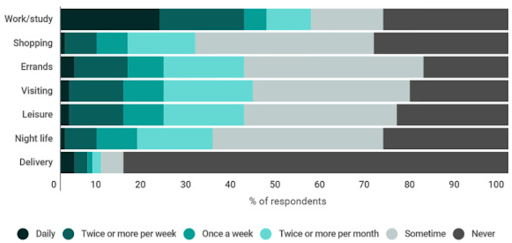
As shown in Figure 1 [3], Categories of Work/Study, Errands, and Shopping can all be related to carrying some luggage either on the way to the destination or on the return journey. Furthermore, the delivery sector avoids micro-mobility due to the lack of storage in such vehicles, giving enough incentive to add some compartments to aid in carrying packages. This improvement will attract new users from the delivery sector and increase frequent usage for dominant sectors.
A study has shown that E-Scooters are incredibly unstable in strong wind conditions [4]. Additionally, weak lateral wind force can also reduce the efficiency of the E-Scooter. The driver will have to steer/lean to counter the wind forces, whichis uncomfortable for the user. Any effort against the wind forces reduces the contact patch of the tirewith the ground leading to a reduced useful power output from the E-Scooter. Taller users are also troubled by the increase in the center of mass that they will bring.
Figure 2 [4] – Diagram representing the aerodynamics affecting a person on an E-Scooter
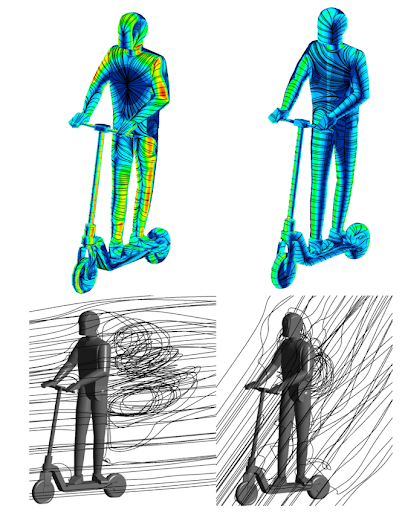
To solve this problem, an aerodynamic stabilizer can be placed beneath the E-Scooters. In skyscrapers, these transfer their weight against the wind force to stabilize buildings. A smaller, rectangular aerodynamic stabilizer placed beneath the E-Scooter platform will greatly benefit the stability of the E-Scooter. It will lower the center of mass and also reduce the effects of the wind forces. The drawback of adding the aerodynamic stabilizers is lower ground clearance and a less agile E-Scooter. The E-Scooter will oppose the sideward force applied by the user while turning, so all the steering will need to be done by the front wheel, and leaning to make the scooter more agile would not work. Due to the streamlined design of the E-Scooter, it becomes harder to balance it and could ruin the riding experience for the user. This also limits the target market to a younger audience that can balance on the scooter for an extended period of time. To combat this, there will be greater mass distribution on the deck of the scooter, so it is easier to find the center of mass and balance. This can be done by increasing the width of the scooter, which will also make it less streamlined to prevent reaching speeds that are too high in harsh, windy conditions.
Safety is at the forefront of micro-mobility policy with rapidly increasing E-Scooter use worldwide. A study was done to determine accident mechanisms and injury patterns among E-Scooter users [5]. The results showed that E-Scooter accidents more commonly occur at night (37% versus 14%), which suggests that visibility is a major issue. Consequently, all E-Scooters must have powerful front LED lights mounted at higher angles to allow the user to see the road and be visible to oncoming traffic. Rear lights are also important for being visible to traffic approaching from behind, allowing both E-Scooter users and car drivers to avoid accidents in the dark.
E-Scooters are widely used by all members of society, including children, teenagers, and adults, who may be taller or heavier; therefore, the device has to be versatile, adapt to different heights, and also be able to withstand higher weights. Handlebars should be adjustable so the user can set the right height for them, and decks should support weights up to 150 kg [6].
Using a material like titanium to build the E-Scooter instead of aluminum like the Neuron E-Scooters can make this more feasible. In terms of the environmental impact, the extraction of aluminum releases lots of greenhouse gases, increasing the E-Scooter’s carbon footprint. As a result, the battery-powered scooter becomes redundant as it leaves a more significant carbon footprint during production, ultimately defeating this electric vehicle’s purpose. The improved design will use titanium instead because it is much easier to extract and more eco-friendly.
It is also stronger and stiffer than aluminum, so that it can withstand the stress applied to it by people of various weights. Using CAD simulation, we monitored the displacement of all components when a human stood on the E-Scooter. To simulate the maximum weight the E-Scooter is expected to handle, a force of 1500 N was placed on the platform, roughly 150 kg. The thickness of each material was kept constant at 2.5 mm; because of this, the weight of both E-Scooters changed from 11.4 kg (Aluminum) to 17.6 kg (Titanium). The only constraint for the testing was keeping the wheels constant and consequently keeping the attachment point of the wheels to the body constant.
Aluminum – Maximum flex experienced is 3.072 mm
Figure 3.1 – Aluminum E-Scooter without force applied
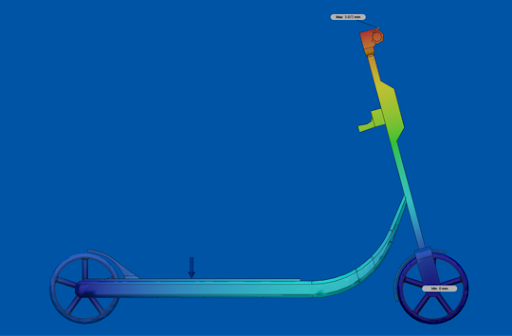
Figure 3.2 – Aluminum E-Scooter with force applied
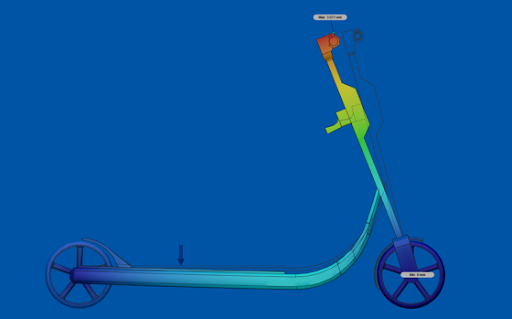
Titanium – Maximum flex experienced is 2.142 mm
Figure 4.1 – Titanium E-Scooter without force
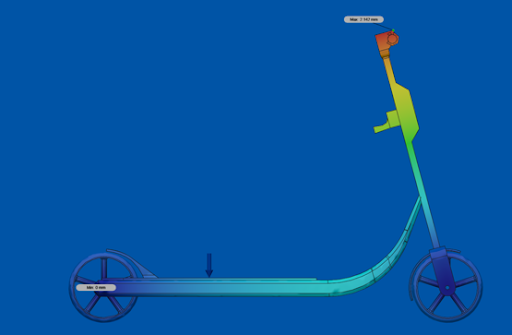
Figure 4.2 – Titanium E-Scooter with force
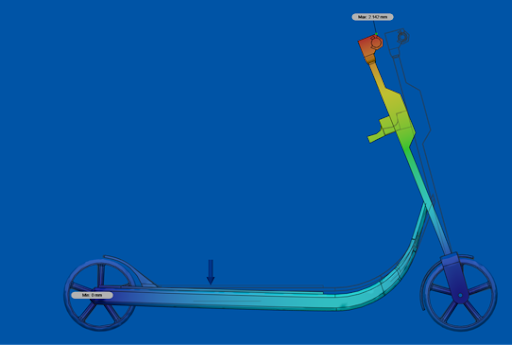
The charging scheme for E-Scooter is 0.18 GBP (Great British Pounds) for every minute traveled. Users will be keen to pay less for each ride and exploit any loopholes in the charging scheme. The current charging system encourages users to take quicker rides to reduce charges. The nature of humans and the pricing makes E-Scooter accident-prone. As micro-mobility became more popular and more people started to use E-Scooters, the frequency of incidents involving E-Scooters increased rapidly [7].
Figure 5 [7] – Graph representing frequency of E-Scooter crashes per month
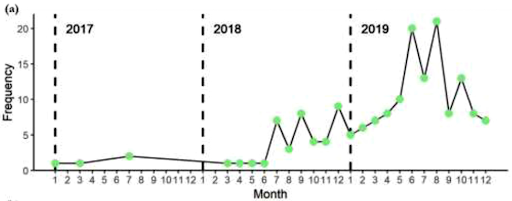
A possible way of reducing E-Scooter crashes will be to implement a new charging scheme, one which involves distance and not the time taken.
Charging Scheme A – Charge users a certain amount per every kilometer of distance covered.
This way, the users will exploit the charging scheme by sticking to just one E-Scooter. They would pay for the distance they traveled every few weeks or months, effectively giving users a private E-Scooter for themselves and restricting new users from using the E-Scooters.
Charging Scheme B – Charge users a total amount per every kilometer of distance covered.
This charging scheme works because the first kilometer has a set amount, 50 cents (amount taken randomly); for example, for each of the following kilometers, the charge for the kilometer increases by 50% (taken randomly). The pricing will follow this pattern.
Table 1 – Sample pricing for charging scheme B
| Distance traveled (km) | Pricing (£) |
| 1 | 0.5 |
| 2 | 0.65 |
| 3 | 0.85 (0.845 rounded to nearest pence) |
| 4 | 1.11 |
| 5 | 1.44 |
| 6 | 1.87 |
Using E-Scooters as personal vehicles will be very expensive and promote shorter journeys. The average straight line distance E-Scooters are used for is between 1 – 2 km[8]; taking routes within a 2 km radius is still reasonably priced, but larger rides will cost a lot.
Figure 6 [8] – Straight line distance of rides in multiple cities
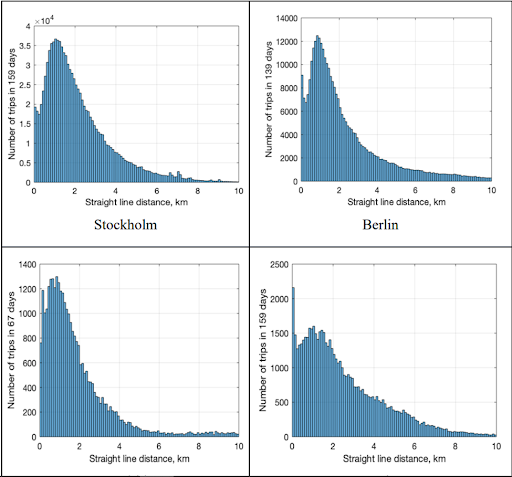
Charging scheme C – Change a certain amount per every kilometer traveled, but use expensive pricing for rides that endures for long periods.
The first few kilometers can be charged normally since the user is riding as expected, but when the time taken to reach the destination is too long, then charge hefty user amounts to restrict people from using E-Scooters for days. The average time taken in journeys on an E-Scooters is between 5-20 minutes [8]. So a good benchmark before charging users a lot would be around 35-45 minutes (depending on city to city).
Physical E-Scooter Redesign
The design of the current E-Scooter can be significantly improved using HFE (Human Factor Engineering) and keeping the user in mind while making the improvements. The improvements will ensure that the E-Scooter caters to a larger audience and promote the rise of micro-mobility. We implemented the ISO 9241-210 iterative design cycle. In each iteration of the E-Scooter design, we evaluated the problems and possible optimizations; then, we figured out the best solution to the problem at hand. Finally, using CAD software, we could alter the design of the E-Scooter to be more user-friendly.
Figure 7 – User-centered design process
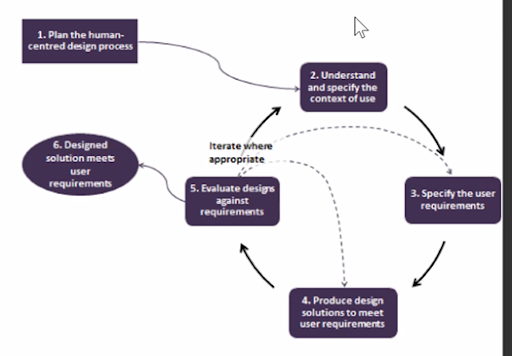
Before any problems or solutions can be drawn, a generic E-Scooter model must be made, acting as the base design upon which all our physical improvements will be made.
Generic E-Scooter Design
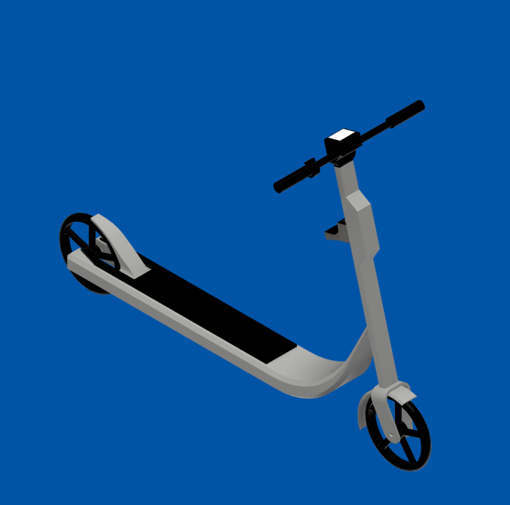
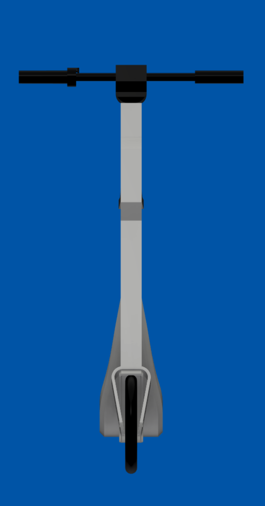
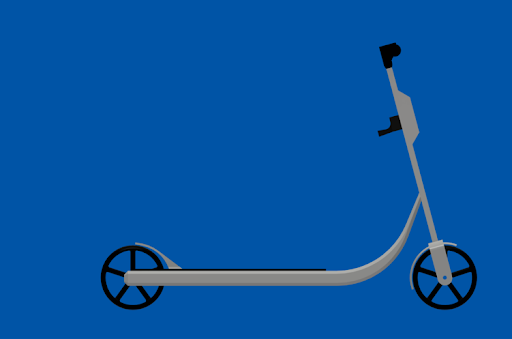
For the further design, we will be color-coding all the components of the CAD design for a better understanding of which components have been modified.
- WHITE – Component modified/to be modified
- BLACK – Un-modified component
Problem 1 – Users who need to carry their E-Scooters for a part of the ride will find it very uncomfortable and inconvenient. Especially when users fall and damage the E-Scooter, or they find un-drivable roads ahead, they will need to carry the E-Scooters to the nearest location where it is safe to drive or to the nearest charging station to report for damage.
Solution – The solution is adding an attachment for a carry strap, allowing for better pressure and force distribution for users looking to carry the E-Scooters. Additionally, it will increase comfort. The cost of the carry strap is the added weight to the E-Scooter.
The strap will be anchored on the handlebar with an empty holder located at the back end of the scooter. The strap can be easily attached and accessible whenever the user desires; the method of carrying is up to the user’s discretion.
Original
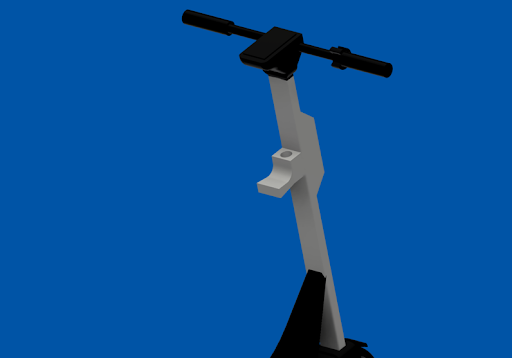
Updated

Original
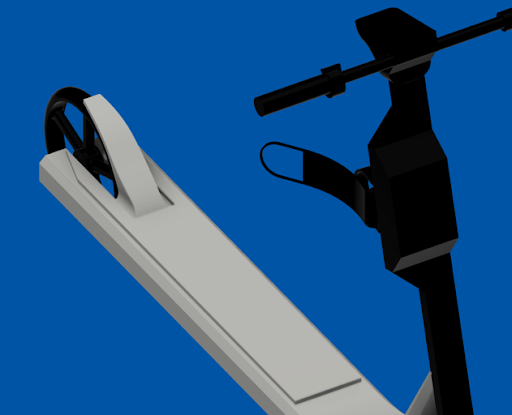
Updated
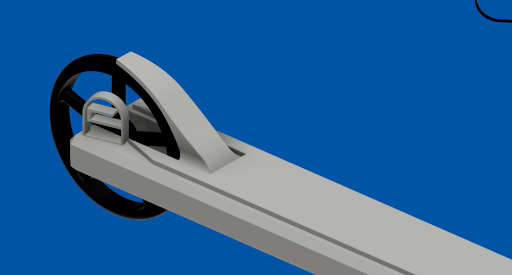
Problem 2 – Geofencing features were limited to the phone, but using the phone while riding contradicted traffic laws [2]. Users would have to stop in order to check traffic laws, leaving room for improvement.
Solution – The solution is to remove geofencing from the app and embed it directly into the HUD by making it more prominent, providing ample space. In addition, enlarging the HUD allows other information and features to be featured in the E-Scooter.
Original
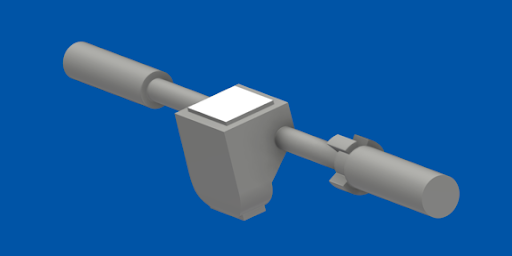
Updated
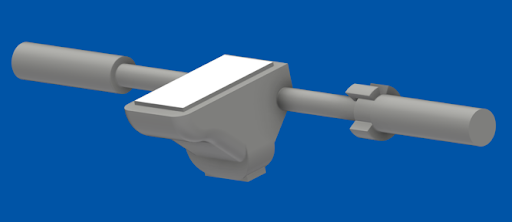
Problem 3 – Lithium-ion batteries are used in all-electric vehicles. These batteries can quickly overheat due to excessive current or cooling problems. In addition, these batteries are hazardous and quick to explode when the conditions are not in the battery’s operating window.
Solution – There are two ways to limit overheating, using a fuse, which breaks the circuit of the E-Scooter when it overheats due to high currents, and using air as a conductor to carry the heat away. They must be exposed to airflow for heat transfer to make this work.
Original
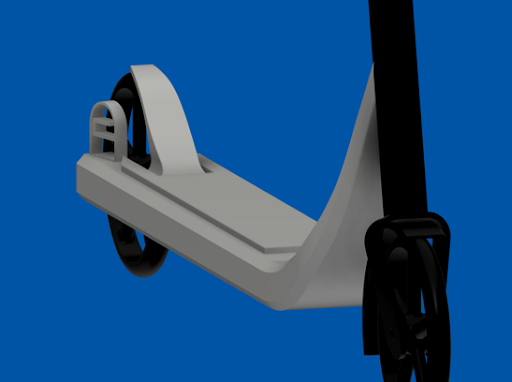
Updated
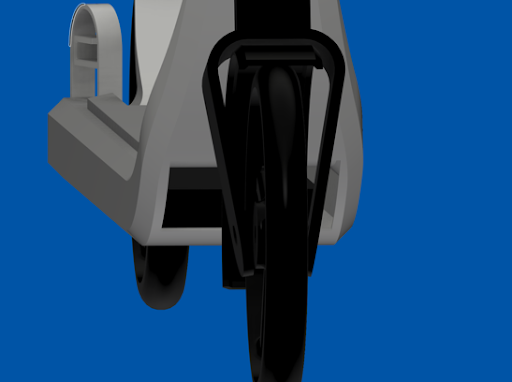
Original
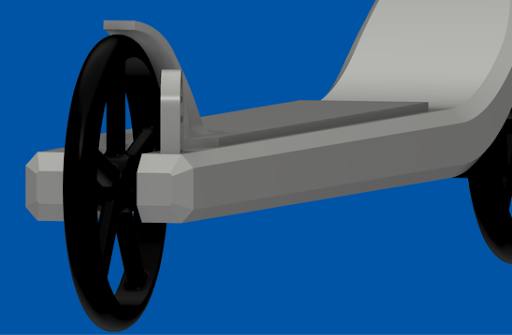
Updated
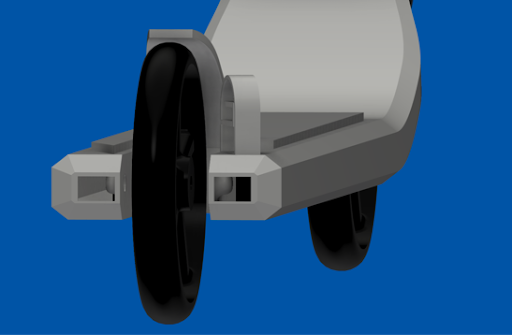
Problem 4 – Many users, while traveling, carry bags with them [3]. However, E-Scooter does not have any provision for luggage. Meaning, users with carry-on bags generally avoid the E-Scooters and prefer other modes of transport.
Solution – The E-Scooter should be equipped with some boot space; users need a space to keep their bags and ride hassle free without disturbances.
Original
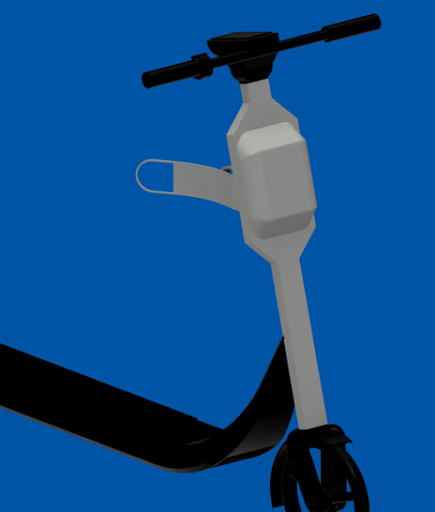
Updated
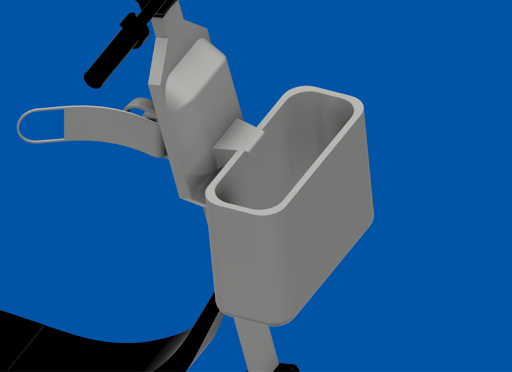
Problem 5 – The E-Scooter is already sensitive to strong winds; this is made worse by certain tall users [4]. Plus, new modifications can move the center of mass higher, and the new components are all non-aerodynamic. As a result, they will be more influenced by cross winds than the typical generic scooter. All of this has made the E-Scooter even more unstable.
Solution – The most obvious improvement would be to make the deck of the E-Scooter larger and allow the user to find the center of balance more quickly. It is also benefiting the user’s comfort. Another technological improvement that can be added to the E-Scooter is aerodynamic stabilizers which will assist the user in aligning the E-Scooter.
Original
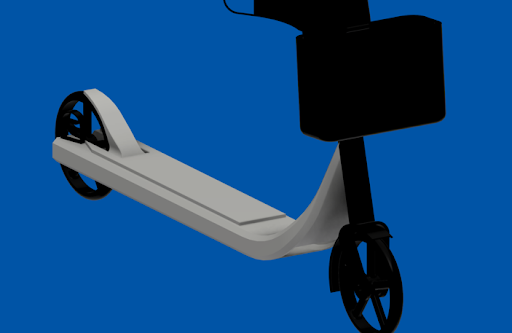
Updated
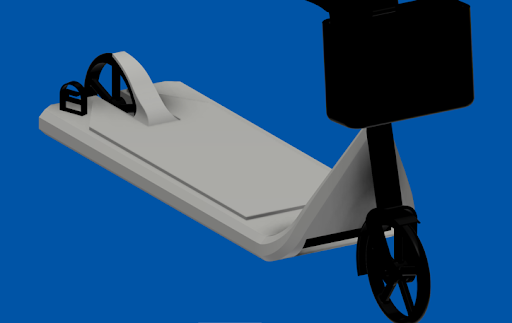
Original
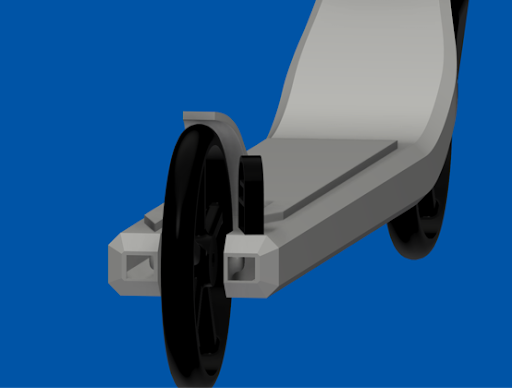
Updated
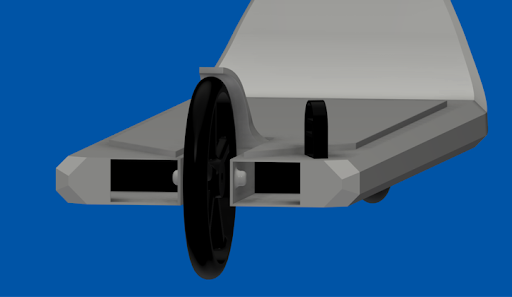
After all the design modifications, the E-Scooter was highly suited for multiple users. A significant change was increasing the width of the E-Scooter deck; this modification gave the design a large increase in surface area, which could be used for optimizing the E-Scooter even further. For example, the battery can now be wider with all other dimensions kept constant, giving a higher storage capacity. The larger battery counters, the range lost from the increased weight; the added components added weight to the system. Since we already know that titanium is much stronger than aluminum, we can reduce its thickness to reduce weight. The modified E-Scooter weighs 16.8 kg and has a lowered center of balance of (-729.324 mm, 215.439 mm, 0.698 mm) compared to (-468.036 mm, 398.162 mm, 4.137 mm).
Figure 9 – Digital render of modified E-Scooter
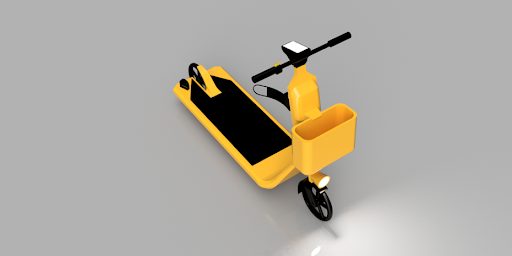
Human-System Integration diagram 1
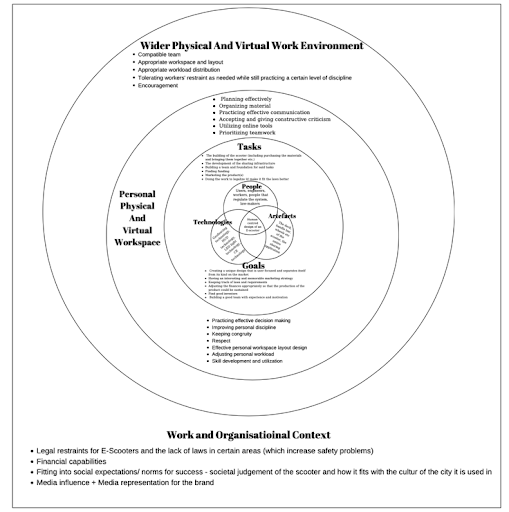
Human-System Integration diagram 2
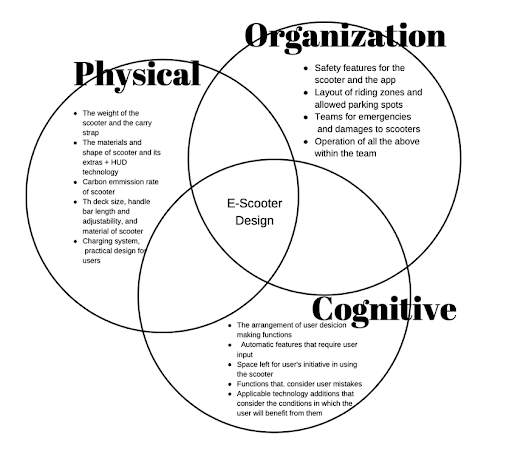
Human-Systems Integration (HSI) is a key approach to any engineering project that aims to be applicable. As also seen on the HSI diagrams above, the physical, organizational, and cognitive aspects of the project should be examined and used to create a manageable final project that considers all three. For a good project, people, technologies, and artifacts need to be considered and broadened by tasks, goals, personal workspace, wider work environment, and the organizational context of the project.
In the case of an E-Scooter design, the users’ physical requirements, the materials’ physical properties, and the environmental impact should be considered. The organization would regulate these with the mindset and abilities of the user in the interaction with computers in mind. Then the design should be considered in a specific manner, considering the users and the workers, the technologies with the best advantages, and the preferable materials. This should bring up tasks and goals in the production, marketing, and use of the scooter. Then there should be a broader analysis of the applicableness by how personal workspace and wider work environment fit into the project. These might be more generic and vague but still provide insight into human systems around the project. Finally, the project must be filtered through work and organizational context to ensure the scooters are accepted, legal, and can be used.
Conclusion
We identified numerous problems and utilized different types of data (including ergonomic data and feedback data from previous users) to improve the design of the E-Scooter. In particular, we looked at improving the Human-Systems Integration to increase the number of users able to use this product and streamline the experience while improving the comfort of the current users. In addition, we made changes to the physical product and its infrastructure, such as the Neuron application, which is required to use the product in the first place.
This is the final E-Scooter design we settled on (right) compared to the original scooter design (left) to demonstrate our physical developments.
The batteries in the vehicle have been made bigger and appropriately exposed to external airflow to increase the E-Scooter’s longevity. The product’s material has been changed from aluminum to titanium to increase the E-Scooter’s general strength. The deck has been widened to aid with the stability & comfort of the vehicle. The headlight has been replaced with one powerful LED to increase visibility. The size of the HUD on the E-Scooter itself was increased to give users as much information as possible, including geofencing on demand, without needing to check their phones which could lead to potential accidents. Carry strap attachments have been added to the design, increasing the comfort of users who need to carry the scooters. The carry strap is practical for carrying up or down stairs and when it needs to be carried in case of accidents. Finally, aerodynamic stabilizers have been implemented to increase the general stability of the vehicle.
Infrastructure-wise, we decided to improve the application by giving it the location of available E-Scooters instead of parking areas that may or may not have E-Scooters available. We also decided to improve the application by having it broadcast the statuses of said available E-Scooters. We also decided to have the safety checks of the E-Scooter automated and to display these results on the now more extensive HUD so the user does not bear that responsibility which could cause them to get into unnecessary accidents due to laziness.
References
[1] – Rhiannon Williams 2020. [Internet][cited 2022 August]. Available from: https://inews.co.uk/news/one-in-five-people-aged-75-and-over-now-use-a-smartphone-245856
[2] – UK Government – Using a phone, sat nav, or other when driving.
[3] – Daniela A, Raky J, Juan C. G, Javier G. 2021. Exploring micro-mobility services: Characteristics of station-based bike-sharing users and their relationship with dockless services. [Internet][cited 2022 August]. Available from: https://www.sciencedirect.com/science/article/pii/S2667091721000108
[4] – Sercan A, Ersen A, Çağlar U. 2021. Aerodynamic Investigation of an E-Scooter & Rider System Through Computational Fluid Dynamics Approach. [Internet][cited 2022 August]. Available from: https://www.researchgate.net/publication/352708698_Aerodynamic_Investigation_of_an_E-Scooter_Rider_System_Through_Computational_Fluid_Dynamics_Approach
[5] – Holger K, Dimitris N, Darius M. T. 2021. Accident Mechanisms and Injury Patterns in E-Scooter Users. [Internet][cited 2022 August]. Available from: https://www.ncbi.nlm.nih.gov/pmc/articles/PMC8204371/#:~:text=E%2Dscooter%20accidents%20more%20commonly,had%20a%20severe%20facial%20injury
[6] – Electric scooter weight limit. [Internet][cited 2022 August]. Available from: https://escooternerds.com/electric-scooter-weight limit/#:~:text=The%20biggest%20weight%20limit%20an,is%20265%20lbs%20%2F%20120%20kg
[7] – Hong Y, Qingyu M, Zhenyu W, Qing C, Kuhn X, Di, Yang. 2020. Safety of micro-mobility: Analysis of E-Scooter crashes by mining new reports. [Internet][cited 2022 August]. Available from: https://www.sciencedirect.com/science/article/abs/pii/S0001457520301135
[8] – Henrik E, Cristofer E, Anne F, Shiva H, Stefan P, Frances S, Alexey V, Johan W. 2020. Electric Scooters’ Trip Data Collection and Analysis. [Internet][cited 2022 August]. Available from: https://www.ri.se/sites/default/files/2021-02/EVS33 Electric_Scooters_trip_Data_Collection_and_Analysis_FinalSubmitted.pdf
Appendix
Appendix A





